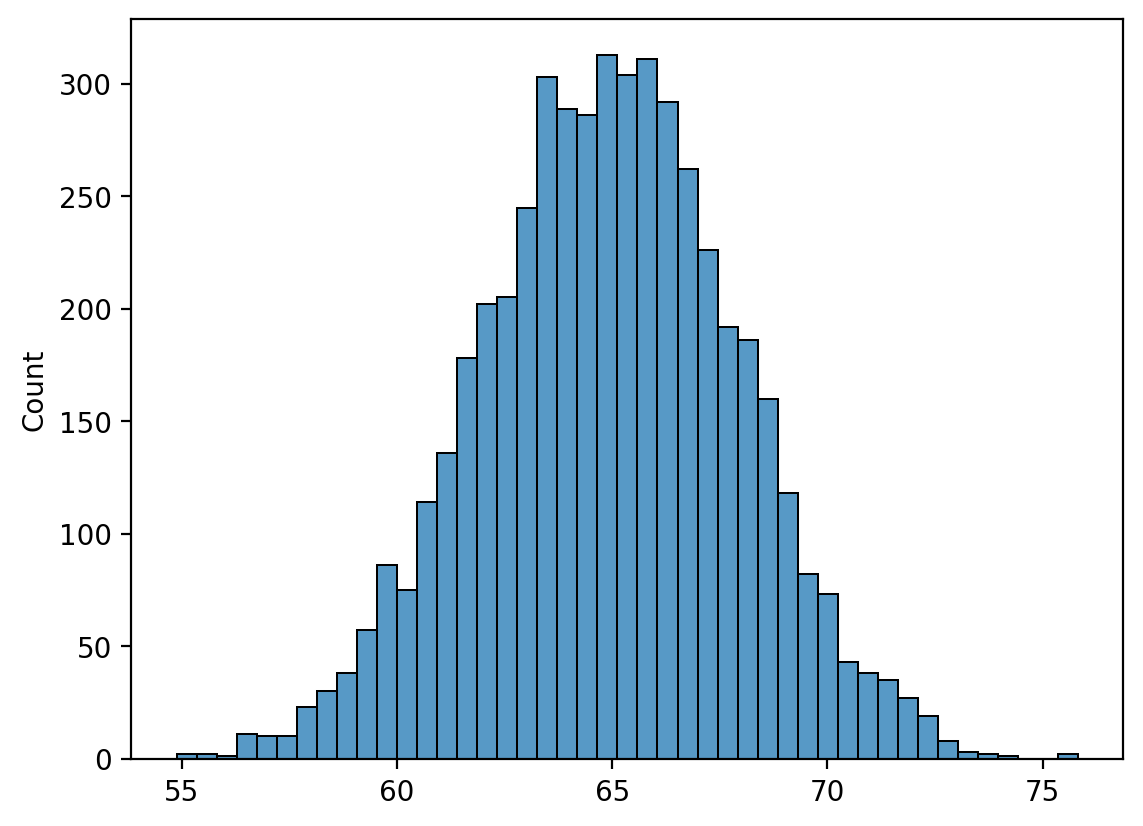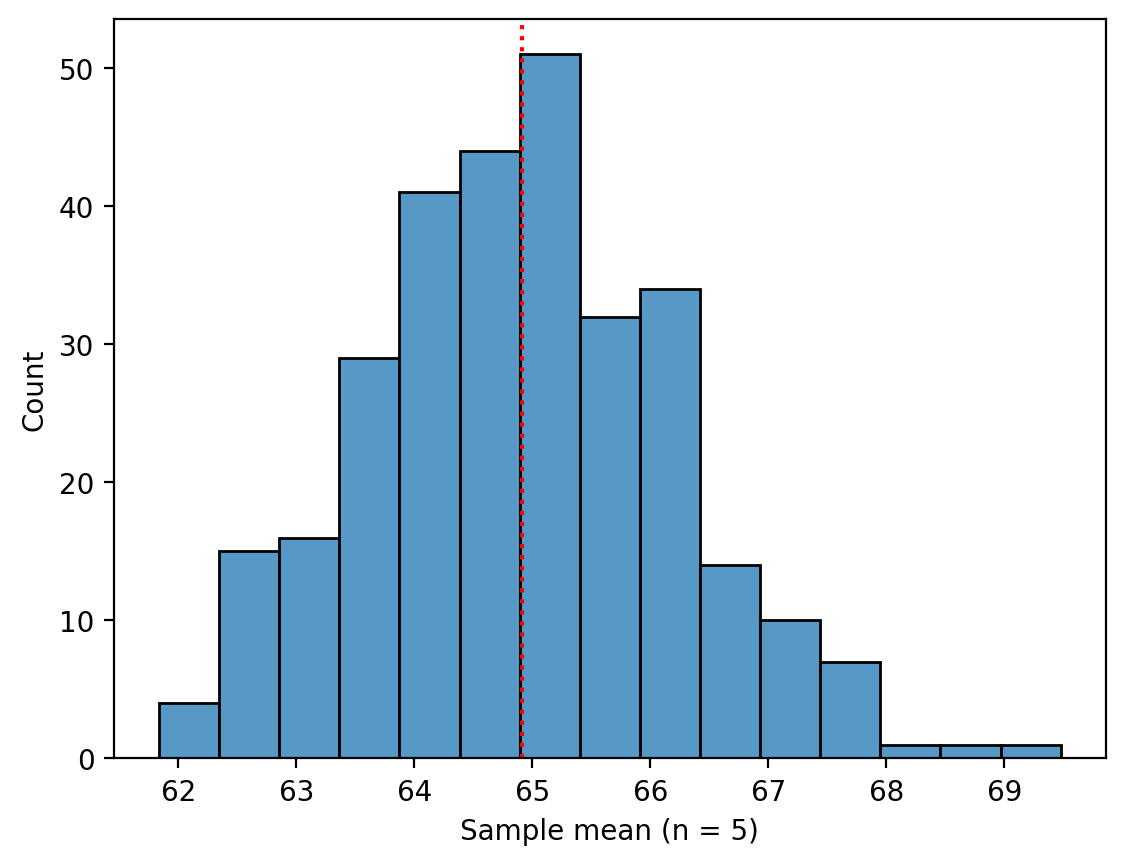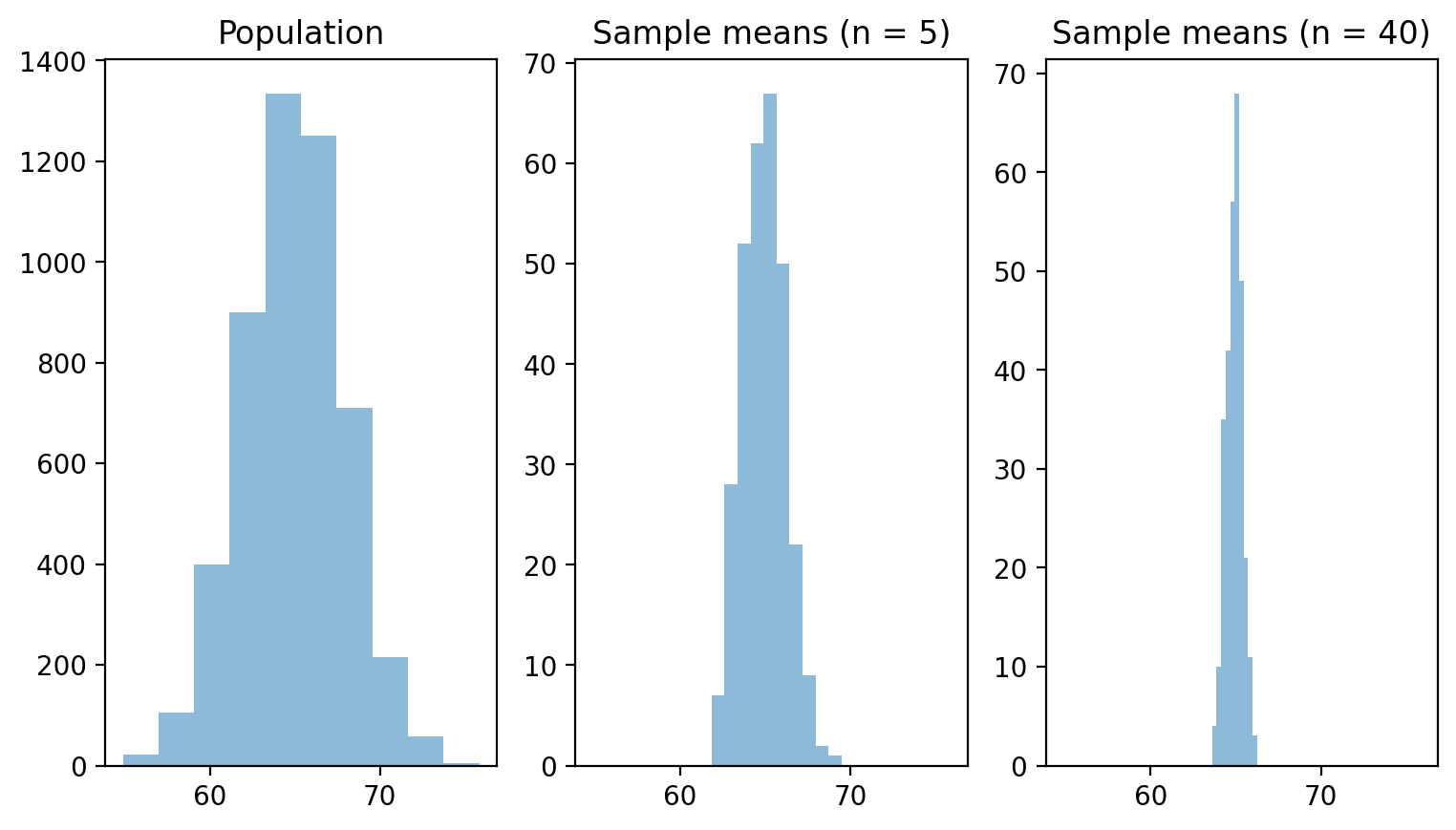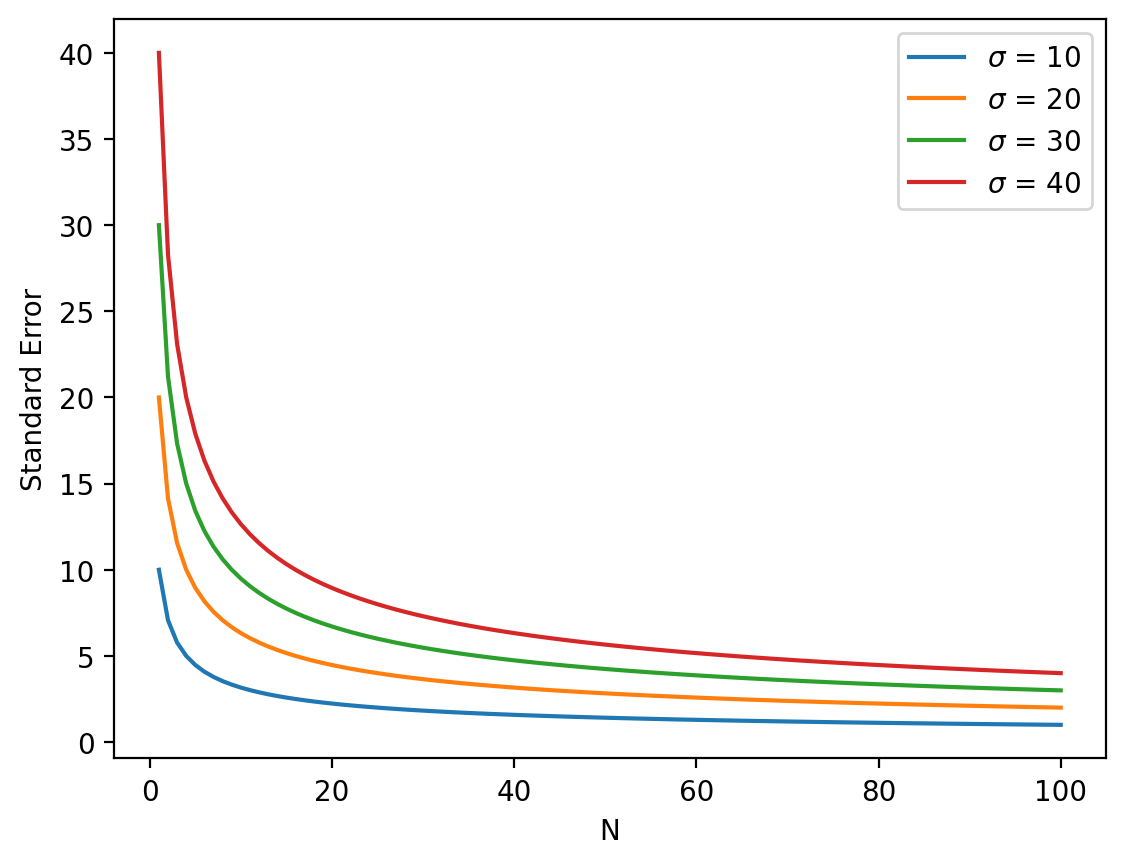Statistics and Sampling#
Importing relevant libraries#
import numpy as np
import matplotlib.pyplot as plt
import seaborn as sns ### importing seaborn
import pandas as pd
import scipy.stats as ss
%matplotlib inline
%config InlineBackend.figure_format = 'retina'
Goals of this lecture#
This is the final lecture before we turn to statistical modeling.
There are a few goals:
Shift from merely descriptive statistics (
mean, etc.) to inferential statistics.Distinguishing samples vs. populations.
Recognizing sampling error.
Standard error and the basics of sampling distributions.
Brief caveat#
This is not an exhaustive introduction to inferential statistics! We will not be covering the details traditional null hypothesis significance tests, including:
t-test
ANOVA
chi-squared test
Rather, I want to motivate a few concepts that will be relevant for a deep understanding of statistical modeling.
Sampling distributions and sampling error
Sampling error
Standard error
Descriptive vs. inferential statistics#
There are at least two shelves in the statistics “toolbox”:
Descriptive statistics: describing the data you have (e.g.,
mean,median,std, etc.).Inferential statistics: trying to generalize from the data you have to a broader population.
Samples vs. populations#
In statistics, a population is a set of potential observations that you’re interested in.
It’s rare to observe the entire population of interest, unless the population is very narrow.
E.g., “All humans across the world” is very broad.
Even “All UCSD students” is a large population.
Thus, we typically rely on a sample.
A sample is an actual set of observations drawn from the population.
The challenge of generalization#
In order to generalize, samples must be random and representative.
Otherwise, we might over-represent or under-represent certain sub-populations.
Unfortunately, many samples are “convenience samples”––whatever’s available at the time.
E.g., “WEIRD” subjects in Psychology research.
Check-in#
What’s an example from earlier in the class of how a non-representative sample can lead to biased models?
Solutions#
An example we discussed was from the Gender Shades paper (Buolamwini & Gebru, 2018), which showed:
We find that these datasets are overwhelmingly composed of lighter-skinned subjects…
And also that:
The substantial disparities in the accuracy of classifying darker females, lighter females, darker males, and lighter males in gender classification systems require urgent attention if commercial companies are to build genuinely fair, transparent and accountable facial analysis algorithms.
Sampling error: a further challenge#
Even if one’s sample is representative, it’s never identical to the underlying population.
Sampling error means that statistics calculated on a sample (e.g.,
mean) will rarely (if ever) be identical to the underlying population parameter.
Illustrating sampling error#
The sample mean (\(\bar{X}\)) will rarely, if ever, be identical to the population mean (\(\mu\)).
## First, create a "population"
np.random.seed(10)
pop = np.random.normal(loc = 0, scale = 3, size = 1000)
pop.mean()
-0.04366990684641133
## Now, sample from that population using np.sample
sample = np.random.choice(pop, size = 100)
sample.mean()
-0.17870546982513766
Check-in#
What if we took a bunch of samples from our population, all of the same size, and calculated the mean of each sample?
What might we call this set of sample statistics?
What do you think would be true of the
meanof this set of sample statistics?
Solution#
This is called a sampling distribution.
This sampling distribution would be normally distributed around the true population mean!
Introducing sampling distributions#
A sampling distribution is the distribution of sample statistics (e.g.,
mean) taken from all possible samples of size \(n\).
Sampling distributions in action#
First, we simulate a ground gruth population.
np.random.seed(seed=10)
pop = np.random.normal(loc = 65, scale = 3, size = 5000)
g = sns.histplot(pop)

Creating the sampline distribution#
Now, we sample from that population 300 times, with each sample size \(n = 5\).
What do we notice about the distribution of those sample means? (Note this is not a “true” sampling distribution in that it’s not every possible sample.)
sample_means_n5 = []
for _ in range(300):
sample = np.random.choice(pop, size = 5, replace = False)
sample_means_n5.append(sample.mean())
g = sns.histplot(sample_means_n5)
plt.xlabel("Sample mean (n = 5)")
plt.axvline(pop.mean(), linestyle = "dotted", color = "red")
<matplotlib.lines.Line2D at 0x14d753650>

Why \(n\) matters#
Now let’s compare several distributions:
The original population
Sampling distribution with \(n = 15\)
Sampling distribution with \(n = 40\)
Creating a new sampling distribution where \(n=40\)#
sample_means_n40 = []
for _ in range(300):
sample = np.random.choice(pop, size = 40, replace = False)
sample_means_n40.append(sample.mean())
Visualizing side by side#
What do we notice about the sampling distribution as \(n\) gets larger?
## Now, we visualize them altogether
f, (ax1, ax2, ax3) = plt.subplots(1, 3, sharex = True)
f.set_figwidth(9)
og = ax1.hist(pop, alpha = .5)
ax1.title.set_text("Population")
og_s1 = ax2.hist(sample_means_n5, alpha = .5)
ax2.title.set_text("Sample means (n = 5)")
og_s2 = ax3.hist(sample_means_n40, alpha = .5)
ax3.title.set_text("Sample means (n = 40)")

Why \(n\) matters (reprise)#
As \(n\) increases:
Sampling distribution looks increasingly normal
The variance of our sampling distribution decreases.
This is, in essence, the Central Limit Theorem.
This is even true of skewed distributions!
Quantifying sampling distribution variance#
A larger \(n\) should increase our confidence that our sample statistic is a good approximation of our population parameter.
Larger \(n\) means lower variance of our sampling distribution.
In turn, this means that any given sample statistic is relatively close to the population parameter.
How might we quantify the amount of variance in our hypothetical sampling distribution?
Introducing standard error#
Standard error gives us a measure of the variance of our sampling distribution.
Standard error (SE) is defined as:
\(\Large SE = \frac{s}{\sqrt{n}}\)
Where \(s\) is the standard deviation of the sample.
Check-in#
How is standard error different from standard deviation?
Standard error depends on \(n\)#
Standard deviation is invariant to the size of our sample.
Standard error gets smaller as our sample size (\(n\)) increases.
SE reflects both standard deviation and \(n\).
Ns = np.linspace(1, 100, num = 100)
for sigma in [10, 20, 30, 40]:
se = sigma / np.sqrt(Ns)
plt.plot(Ns, se, label = "$\sigma$ = {x}".format(x=sigma))
plt.legend()
plt.xlabel("N")
plt.ylabel("Standard Error")
Text(0, 0.5, 'Standard Error')

Caclulating SE with pandas#
pandas gives us a function (sem) to calculate standard error of the mean (SE) directly on a column.
df_height = pd.read_csv("data/wrangling/height.csv")
df_height['Father'].sem()
0.08363032857029366
Reporting standard error#
A common way to use standard error is to report it alongside the sample mean:
The mean of our sample was \(25\), \(\pm 3.5\) (SE).
That “\(\pm\)” symbol just indicates some uncertainty about our sample statistic.
Conclusion#
This concludes our brief foray into inferential statistics.
The goal was primarily to introduce a few key concepts:
Sampling error: sample statitics ≠ population parameter.
Sampling distributions: a distribution of all sample statistics from samples of size \(n\).
Standard error: a quantification of the variance in our sampling distribution.
Together, these concepts will help ground future discussions of statistical modeling.
